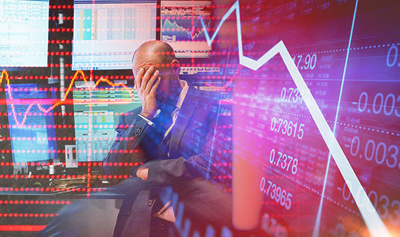Dow 10,000
Bill Bonner
December 10, 2018

BALTIMORE, MARYLAND – Trading continued yesterday… with stocks swinging lustily from tree to tree like drunken monkeys.
When the closing bell finally sounded, the Dow was down just 79 points. The monkeys were greatly relieved.
And today, the Fed sets up another drink. Here’s a headline from The Wall Street Journal:
But stocks are now falling. Worldwide, about $5 trillion has already been knocked off stock values. The S&P 500 is about 10% below its top in September. And the FAANG stocks – the leading technology stocks – are down about 25% from their highs.
Still, they’ve got a long way to go.
Warren Buffett’s favorite yardstick for valuing stocks measures the relationship of total market capitalization (the value of all stocks added together) to GDP. The ratio should be well below 100%. Stocks cannot be worth much more than the GDP of the country that supports them.
But this ratio is now as high as it’s ever been – it’s about even with the top of the great bubble market of 1999.
Stocks today are equal to about 150% of GDP. The Dow would have to fall by nearly 50% to get back to normal.
Dow 10,000
Another, more indirect, way to look at it is to compare U.S. household net worth (which includes real estate, bonds, and stocks) to national output.
Since housing, collectibles, art, bonds, and just about everything else are all up substantially, this ratio is at a new record high – at 5 times GDP. Stocks (and other assets) would have to drop by about 30% to bring this back to its historical average.
Another calculation looks at the number of hours the typical person would have to work to buy the S&P 500 Index
.
Take 1980, for example. Based on median wages and the S&P trading around 120, it took only 20 hours of toting, schlepping, and busting one’s hump to buy the 500 stocks in the index.
Today, it takes 120 – a new record. The average since the 1960s is only about 50. That implies a setback for stock prices of about 60%.
Dow 10,000… Here we come!
Greenspan Put
But not to worry. Investors think they have both the Fed and the White House backing them up.
You’ll recall the famous “Greenspan Put.” The idea, developed after the 1987 crash, was that the Alan Greenspan-led Fed would come to the aid of stock market investors and prevent any permanent losses.
Prices could fall suddenly and sharply, but it wouldn’t take the Fed long to come to the rescue. In the late 1980s/early 1990s, for example, the Fed cut some 700 basis points – 7% – off the federal funds rate, causing the bubble market of the late 1990s.
Then, after the inevitable dot.com blowup, once again, Greenspan rushed in where angels feared to tread. The federal funds rate was cut by 500 basis points, a welcome increase of spirits in the punchbowl.
And it did the trick; the EZ-money party soon started up again.
Greenspan’s successor, Ben Bernanke, used this magic again after stocks collapsed in 2008-2009. This time, though, he started from a lower position, with only about 500 basis points available.
In the panic, he cut them all… down to zero. He also increased the Fed’s monetary base – by inventing nearly $4 trillion of new money with which to buy bonds.
Again, the remedy worked – in the sense that it reinflated the bubble.
So investors are probably thinking that another big downturn will be followed by another big rescue.
They may be right, too, in thinking that they now have the president of the United States in their corner, as well as the Fed.
President T. knows that he will be the biggest loser in a bear market. His reputation as a financial master will be ruined. His political career (notably, his chances of re-election) will be trashed. And his own fortune will get banged up badly, too.
Trump will do whatever he can to keep prices rising on Wall Street – including pressuring the Fed to cut rates… announcing a phantom trade deal with China… running huge deficits… cutting taxes… or simply talking up the economy with his usual mixture of real bravura and counterfeit facts.
But this time, it may not be so easy to restart the party.
Negative Territory
First, the Fed now has only 225 basis points to work with. It can cut them. But then, it will be in negative territory.
But since the inflation rate is about 2.50%… it is already in negative territory, in real terms.
Diving deeper into the dark pool could have some very strange and unwelcome consequences. The Fed will be chary of doing so. (But it will go for it anyway… as we will see.)
As for the president, he will respond as expected, too. He will come up with his own Bush-style TARP program – focused on infrastructure boondoggles.
But like the Fed, he starts from a weaker position than Bush did. The feds are already running a $1.2 trillion deficit. Their knees will quake at the thought of a $2 trillion deficit.
That won’t stop them, of course… but the additional deficits will drive up consumer prices, and probably result in some form of stagflation in the economy.
Debt will soar. Growth will slump.
And how about stocks? Will they go up again, as both Trump and Powell exercise their “puts”?
Not necessarily.
The Japanese had plenty of puts, too, and used them all after their bubble popped in 1989. But the Nikkei index never recovered. It’s still down 30% – 30 years later!
When the next crash comes, it could be decades before we see the Dow at 26,000 again.
Stay tuned…
- Article sourced here -
dub









